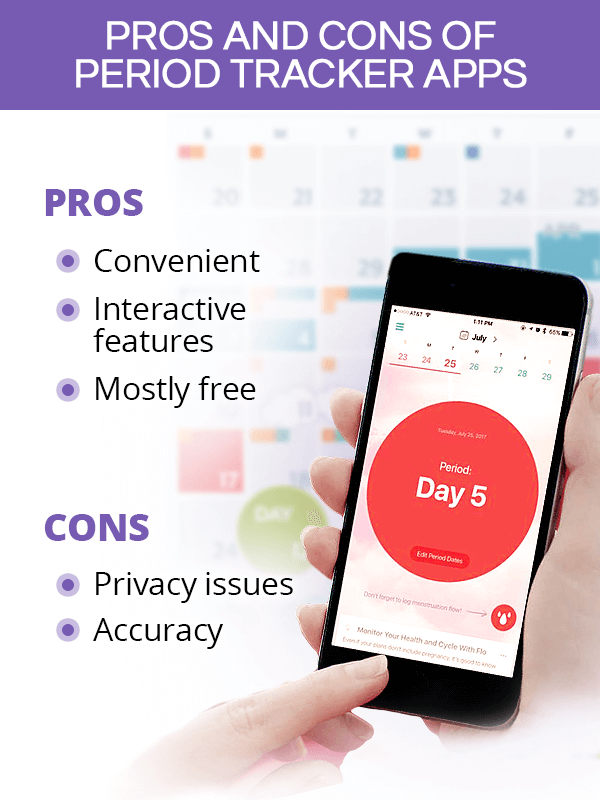What are Period Trackers?
Period trackers are mobile applications that allow women to register their period information to note their patterns. Surveys show that phone applications are the most common method of period tracking, with 47% of interviewed women choosing them over other methods.1
Many period trackers are available at no charge, although some may offer paid plans for additional features.
Basic features across most apps include period charting (period dates and their length) and forecasts regarding upcoming periods, ovulation, and fertile days.
Advanced features may include a detailed cycle analysis, advanced charting options (including period symptoms or intercourse log), user community, wellness articles and other resources, personalized support, and more.
Some of the most popular period tracker apps include Clue, Eve, Glow, and Spot On. A period tracker might also be included in a more complex health tracking application, such as Apple's HealthKit or Google Fit.
How do Period Trackers Work?

To make their estimations, period tracker apps are programmed to use the same principles a woman would follow if she was using a manual period calendar and doing her calculations by hand. They include the following:
Based on recorded dates of the last three to six periods, a period app will calculate the average length of a woman's menstrual cycle.
Knowing her average cycle length, the app can predict the dates of the next three to six periods by simply adding that number to the last recorded period date.
Once the next period date is predicted, the app counts back 14 days from that date to estimate ovulation. Most apps will mark five days before and one day after ovulation as the fertile window, during which a woman can get pregnant.
Advanced options generally include a thorough analysis of one's cycle patterns in comparison to the accepted definition of healthy menstruation, including the following:2,3,4
- A healthy cycle lasts from 21 to 35 days.
- Bleeding days last from 3 to 7 days, with 5 being an average.
- Normal period symptoms, including mild breast tenderness, bloating, and cramps, may start a day or two before and a day or two into a period.
Pros and Cons of Period Tracker Apps

Period trackers are highly popular among menstruating women due to numerous advantages involved in their use. However, there are several disadvantages to consider when choosing the right application. They are as follows:
Pros of Menstrual Cycle Trackers
Convenience. Women often praise period trackers for allowing convenient storage of all menstruation-related information in one place.
Reminders. With enabled notifications, a period app can send women reminders to log their periods, making it easier not to fall behind. It can also notify them about an upcoming period or nearing fertile window.
Cons of Menstrual Cycle Trackers
Privacy. Since menstrual cycle trackers are created by third parties and hosted online, there is a risk of women's sensitive information reaching unauthorized hands.
Accuracy. While period trackers' predictions may be accurate for women with regular menstruation, it may be difficult for women with irregular periods to obtain a reliable estimation. In fact, a study has shown that out of 33 studied period apps, only three accurately predicted the fertile window.5
How to Choose the Best Period Tracker
Since each woman's menstrual needs and personal preferences are different, there is no such thing as one best period tracker that will work for all.
Nevertheless, when trying to choose the best menstrual tracker for one's needs, there are several key points worth considering, including available features, cost, privacy settings, layout design, and accuracy.
Additionally, it is worth reading reviews online or asking female friends for more personalized recommendations. It is common for women to experiment with two or more period apps before finding one that suits one's preferences.
Key Takeaways
Period trackers are the most popular method of keeping record of menstrual patterns. They come in a wide variety of types and are equipped with attractive, interactive features. Besides storing period data, basic - and usually free - features also include estimates regarding the dates of the next periods as well as ovulation and fertile window. More advanced and generally paid features offer detailed cycle analyses, advanced charting options, and educational resources. Period tracker apps are widely praised for how convenient they are, allowing for easy storage of period info and a notification system to stay on top of one's journaling. Their criticism mainly revolves around privacy issues and doubtful accuracy, especially for women with irregular periods. Nevertheless, they can be a beneficial tool in terms of monitoring and understanding one's health.
Sources
- Better Health Channel. (2018). Menstruation - pain (dysmenorrhea). Retrieved June 30, 2020 from https://www.betterhealth.vic.gov.au/health/conditionsandtreatments/menstruation-pain-dysmenorrhoea
- FDA. (2018). FDA allows marketing of first direct-to-consumer app for contraceptive use to prevent pregnancy. Retrieved June 30, 2020 from https://www.fda.gov/news-events/press-announcements/fda-allows-marketing-first-direct-consumer-app-contraceptive-use-prevent-pregnancy
- Health Direct. (2018). Menstruation (periods). Retrieved June 30, 2020 from https://www.healthdirect.gov.au/menstruation
- Medline Plus. (2020). Menstruation. Retrieved June 30, 2020 from https://medlineplus.gov/menstruation.html
- Office on Women's Health. (2018). Menstrual Cycle. Retrieved June 30, 2020 from https://www.womenshealth.gov/menstrual-cycle/your-menstrual-cycle
Footnotes:
- Proceedings of the SIGCHI Conference on Human Factors in Computing Systems. (2017). Examining Menstrual Tracking to Inform the Design of Personal Informatics Tools. Retrieved June 30, 2020 from https://www.ncbi.nlm.nih.gov/pmc/articles/PMC5432133/
- The Society of Obstetricians and Gyneacologists of Canada. (n.d.). Normal Periods. Retrieved June 15, 2020 from https://www.yourperiod.ca/normal-periods/menstrual-cycle-basics/
- Clinical Evidence. (2012). Menorrhagia. Retrieved June 30, 2020 from https://www.ncbi.nlm.nih.gov/pmc/articles/PMC3285230/
- Better Health Channel. (2018). Ovulation. Retrieved June 30, 2020 from https://www.betterhealth.vic.gov.au/health/conditionsandtreatments/ovulation
- Obstetrics & Gynecology. (2016). The Accuracy of Web Sites and Cellular Phone Applications in Predicting the Fertile Window. Retrieved June 30, 2020 from https://pubmed.ncbi.nlm.nih.gov/27275788/
